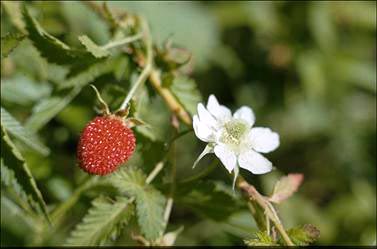The Rose Family
 |
 |
| Rosaceae cross section |
Rosa rugosa |
The Rosaceae are found mostly in temperate regions of eastern Asia, Europe, and North America. The family contains 100 genera and 2000 species. In the United States and Canada alone there are 62 genera and 870 species, the largest genera being Rubus, Cratagus, and Potentilla.
Click here for a distribution map of the Rosaceae in the U.S.A.
Vegetative Characters | Reproductive Characters |
Diagnostic Characters | Economic Importance/Fun Facts
| Evolutionary Adaptations and Relationships | Glossary of Terms |
References and Links | Pictures
- trees, shrubs, or perennial herbs
- thorns or prickles often present
- leaf complexity variable
- margins serrate
- stipulate
- arrangement alternate, cauline, or basal rosette
Back to top
- inflorescence variable
- flowers actinomorphic
- perigynous to sometimes epigynous
- hypanthium with a nectariferous disc
- epicalyx sometimes present
- calyx of 5 sepals, basally connate
- corolla of 5 distinct petals, caducous
- many whorls of stamen with the inner shorter than outer
- 1-many carpels, distinct to (2-5) connate
- axile placentation
- fruit type variable
Back to top
- distinctive family characters = actinomorphic, perfect flower with a prominent cup-like hypanthium and many exserted stamens
- characteristic leaves, margins serrate (can be seen on the stawberry plant pictured below)
- due to hybridization, some species delimitations are difficult (mostly ornamental ones)
Back to top
- edible fruits: strawberry, pear, apple, almond, apricot, cherry, nectarine, peach, blackberry, etc.
- medicinal Prunus (apricot seeds) and Rosa (rose hips)
- Perfumes
- Ornamentals
Back to top
- The Rosaceae are a monophyletic group with four subfamilies mainly based upon gynoecial and fruit characters
- due to hybrids (especially in ornamental genera) and apomixis can be much different in morphology than that described above, eg. petal #
- cultivated roses that we buy in the store are modified to have many showy petals which are derived from the many stamen in the ancestral roses
Back to top
- epicalyx - an involucre outside the true calyx
- involucre - a whorl of bracts
- caducous - falling off very early
- exserted - projecting beyond another structure
- apomixis - asexual reproduction, specifically when part of a plant breaks off and develops into a separate individual
Back to top
- Zomlefer, Wendy B., 1994. Guide to Flowering Plant Families. The University of North Carolina Press Chapel Hill, NC USA.
- Judd, W. S., C. S. Campbell, E. A. Kellogg, P. S. Stevens. 1999. Plant Systematics: a phylogenetic approach. Sinauer Associates, Inc. Sunderland, MA U.S.A.
- http://biology.clc.uc.edu/graphics/bioall/families/Rosaceae%20flower.gif
- http://www.life.uiuc.edu/plantbio/260/Rosaceae/R17.jpg
- http://courses.washington.edu/~bot113/images/slide114.jpg
- http://forestry.msu.edu/uptreeid/PICShardwoods/JUNE-header.jpg
- http://www.anbg.gov.au/images/photo_cd/732131822181/044_2.jpg
- http://www.hcs.ohio-state.edu/hcs300/gif/cd0638-39.gif
Back to top
 |
 |
| Rosaceae tree with its flower |
Prunus |
 |
 |
| receptacle with achenes + flower |
hawthorne flower |

Back to top
For questions or feedback, contact:
Kimberly Nelson







